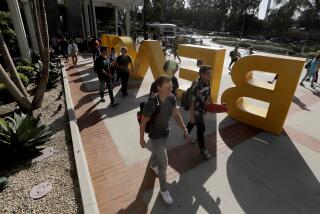Be Fair to Two-Year Colleges
- Share via
A dozen Los Angeles airport police officers spent Wednesday in Hollywood studio sets of airline fuselages and coffee shops learning how to respond to gunfire and other lethal threats on airliners and in crowded airports. The so-called simunitions class takes place on sets at West Los Angeles College’s Aviation Center and is part of a series under the umbrella title “Emergency Management of Terrorism.” The courses could hardly be more timely or important, but they are threatened by proposed state budget cuts.
West L.A. College and other community colleges increasingly provide on-the-job training, along with classes to train nurses, paramedics and skilled child-care workers, chronically understaffed trades that don’t necessarily require four-year university degrees. Such responsiveness to employers is one hallmark of the two-year schools.
The colleges provide otherwise out-of-reach opportunities to low-income and often immigrant families. When students spend two years at low-cost community colleges before transferring to University of California or California State University campuses, that saves money for the university system -- and taxpayers.
Why, then, would Gov. Gray Davis propose a budget cut of nearly 10% in the statewide community college system, even as he sets aside hundreds of millions of dollars to pay for increasing enrollment in the UC and Cal State systems? The result would be an increase of nearly 5% for UC and a smaller rise for Cal State.
The community colleges have no sports teams and few famous grads to provide political clout and haven’t had much luck fighting cuts in the past. But they’re learning to work a populist theme, having mounted protests last month against the cuts in Los Angeles and Sacramento. State Sen. Richard Alarcon (D-Sylmar) distilled the message at the Los Angeles rally: “We need to maintain the promise that was made after World War II, and show that working-class people are smart too.”
The community colleges will have to absorb some pain and should accept Davis’ proposal to more than double student fees. That may sound like soaking the poor, but the increase would boost fees only from $11 to $24 a unit, still the lowest in the nation. Students having trouble paying could apply for federal Pell grants, currently unavailable because the $11 fee is below a “total cost of attendance” threshold. Another source of help is the state’s Cal Grant program.
After that, Davis needs to get his priorities straight. California’s job market doesn’t need just advanced physics degrees and MBAs, as the current nursing shortage attests. No one wants to see prestigious UC bled dry of funds, but in the interest of fairness it should -- just temporarily -- forgo part of its increase.
More to Read
Sign up for Essential California
The most important California stories and recommendations in your inbox every morning.
You may occasionally receive promotional content from the Los Angeles Times.










